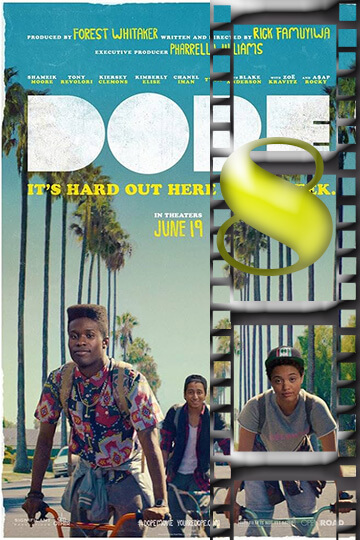
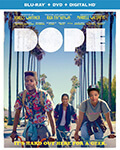
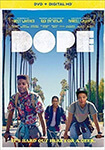
WHAT’S IT ABOUT
High-school senior Malcolm (Shameik Moore) and his friends Jib (Tony Revolori) and Diggy (Kiersey Clemons) bond over ’90s hip-hop culture, their studies, and playing music in their own punk band. A chance encounter with a drug dealer named Dom lands Malcolm and company at the dealer’s nightclub birthday party; when the scene turns violent, they flee — with the Ecstasy that Dom secretly hid in Malcolm’s backpack. A wild adventure ensues as the youths try to evade armed thugs who want the stash.
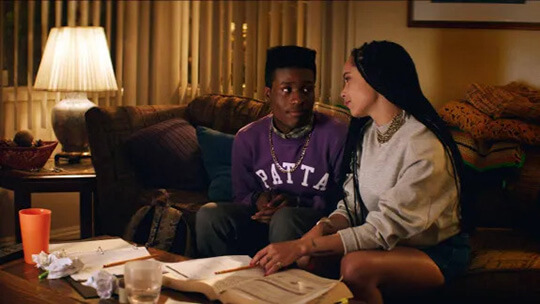
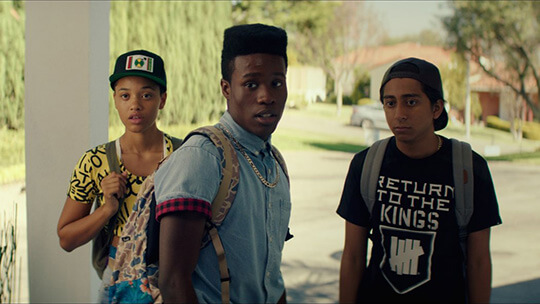
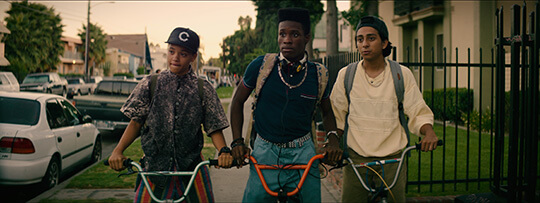
MOVIESinMO REVIEW
Rick Famuyiwa’s “Dope” appeared during a critical moment in culture in 2015, slicing through familiar narratives around Black youth in inner-city America with sharp shine and unstoppable swagger. Malcolm (Shameik Moore), the self-proclaimed “geek,” guides us through the turbulent terrain of Inglewood, California, accompanied by his fellow dweeby friends Jib (Tony Revolori) and Diggy (Kiersey Clemons). These ’90s hip-hop addicted kids with a punk band called Awreeoh (pronounced “Oreo”) are a welcome respite from the generic young Black film characters. What strikes you immediately about “Dope” is its vibrantly kinetic visual style. Famuyiwa’s direction, paired with Rachel Morrison’s kinetic cinematography, creates a sun-blessed Los Angeles that throbs with life and peril in equal measure. The color palette – deep yellows, deep blues, and vivid reds – picks up both the youthful idealism of our heroes and the hard-knock realities of their environment. The appearance of the movie is at once nostalgic and fiercely contemporary as if Malcolm’s vintage flat-top and the crew’s vintage cool. The action kick-in is when Malcolm attends a birthday party of a drug dealer and unwittingly becomes saddled with a backpack of MDMA. What follows is a coming-of-age tale, crime caper, and social commentary all at once when Malcolm and his crew have to navigate a delicate situation while trying to remain on course with their academic aspirations. The stakes are really high – college admission (Harvard, specifically), bodily harm, and whether there is space for Black excellence without strings attached. Shameik Moore delivers a standout performance as Malcolm, finding a perfect balance of book-smart awkwardness and street smarts as needed. His is the tightrope that so many young Black men are compelled to walk – being smart enough to escape their circumstances but street smart enough to survive them. Moore plays this duality to wonderful subtlety, particularly in scenes where Malcolm must code-switch between academic success and survival in the ‘hood. The supporting cast gleams equally well. Zoë Kravitz playing Nakia brings depth to what could otherwise have been too-atypical for-the-masses love interest material, A$AP Rocky makes an impression playing Dom with some strong dramatic twists, and Kiersey Clemons’ stinging portrayal of Diggy – a queer young female who doesn’t codify her entire existence into the fact of being queer – comes across particularly visionary for 2015. What sets “Dope” apart from being just another teen comedy is that it can address tough social issues without being preachy. In Malcolm’s Harvard application essay story in the film, the film tackles the double standards Black youths are supposed to live by: “Why do I want to attend Harvard? If I were white, would you even have to ask me that question?” This scene sums up the overall theme of the film – the unfair expectation of Black excellence to constantly justify and explain itself. The script wisely probes how the hustler genre has been transformed by technology and internet culture. Malcolm and his crew aren’t selling drugs on street corners; they’re buying and selling Bitcoin on the dark web. Their technological savvy doesn’t make their predicament any less dangerous, but it does update the “hood movie” for a generation that navigates the real and virtual worlds with equal ease. Famuyiwa’s tone is a delicate balance. One moment, we’re caught in the midst of a tense drug deal; the next, we’re watching Malcolm bumble through a crush or a band practice. These shifts may be jarring, but they are also true to the reality of growing up in areas where happiness and danger coexist. The movie’s soundtrack is itself something special – a genius marriage of ’90s hip-hop icons and specially written songs by the cast. Music isn’t just used here as background; it’s used to bring characters to life. Malcolm’s obsession with ’90s hip-hop tells us all about his devotion to reconnecting with an envisioned golden age of Black ingenuity that existed before him, and the Awreeoh band cuts (composed by Pharrell Williams) are the characters’ current ingenuity. Where “Dope” falters occasionally is in its third act, when it sets up a number of plot threads that don’t neatly pay off with the same braininess as the set-up. Some characters go missing too easily, and the ending, although emotionally satisfying, asks for a little suspension of disbelief as to how tidily some of these perilous circumstances are resolved. The movie’s exploration of identity rings especially true. Malcolm is constantly faced with versions of the question: “Who do you think you are?” It’s asked by everyone from admissions officers at colleges to drug dealers, all looking to put him in a box that he won’t fit into. The ultimate thesis of the movie seems to be that authentic identity for young Black people often means the same kind of rejection of fictive dualisms – you don’t necessarily have to be either intelligent or street-intelligent, hip-hop or punk-rocks, embracing or surpassing your ‘hood. “Dope” arrived at a moment when talk about Hollywood diversity was all but leaning (the #OscarsSoWhite campaign would come just a few months later). Its critical and box office success helped demonstrate audiences’ hunger for narratives of Black life outside of the trauma arc. While the film does not shy away from the realities of drugs, violence, and systemic inequality in cities like Inglewood, it will not turn these elements into the entire story. What keeps “Dope” going all these years on is the manner in which it intersects prior to intersectionality ever being a concept that had penetrated most folks’ popular lexicon. Malcolm is not just Black; he’s a nerd, a musician, a student, a friend, a potential perp, and a potential Harvard student all at once. The film continues to insist upon his multidimensionality in ways mainstream films never afford Black teen protagonists. As a Black spectator of “Dope,” what rings true is its rejection of respectability politics while still honoring intellectual striving. Malcolm doesn’t transcend his blackness to advance; he labors with all of himself and his life. The movie suggests that survival, at times, can take the form of using the stereotypes which other individuals project upon you as camouflage while secretly going after your own definition of success. Since its release, the years have only served to make “Dope” earn its title – new, strong, and somewhat dangerous to the status quo. Its dynamic storytelling and refusal to sanitize narratives about Black youth in America make it an essential addition to the coming-of-age film lexicon. Even with some third-act stumbles, Famuyiwa’s energetic direction and the cast’s genuine performances create a film that is fun and necessary. A lively, thoughtful examination of Black identity that is equally confident in its balance of tension, humor, and social commentary.
OUR RATING – AN INGLEWOOD 8
MEDIA
- Genre – Comedy
- Street date
- Digital/Blu-Ray/DVD – October 13, 2015
- Video – 1080p
- Screen size 2.40:1
- Sound – English DTS-HD Master Audio 5.1
- Subtitles – English SDH, French, Spanish
Extras
- Dope is Different (HD, 3 min) – Presented in 1080p with Dolby Digital 2.0 audio, this is a short featurette with cast and crew interviews discussing the film’s story and characters. Unfortunately, this is light on insights and heavy on plot summary.
- Dope Music (SD, 3 min) – Presented in 1080p with Dolby Digital 2.0 audio, this is another short featurette with cast and crew interviews. This time the focus is on the movie’s original music and loving nods to 90s hip-hop.

